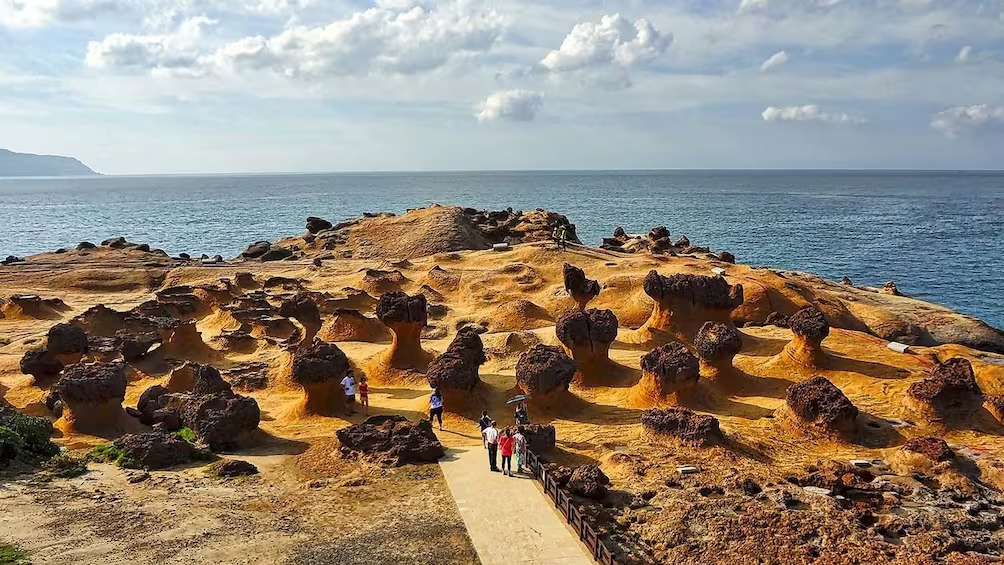







A Travel Guide to Taiwan
Taiwan, a vibrant island in East Asia, is a captivating blend of modernity, tradition, and natural beauty. Known for its bustling night markets, ancient temples, towering skyscrapers, and lush landscapes, Taiwan offers a diverse range of experiences for travelers. From the dynamic capital of Taipei to the serene beaches of Kenting, this guide will help you plan an unforgettable trip to Taiwan.
Why Visit Taiwan?
Taiwan is a destination that caters to all types of travelers. Foodies will delight in its world-famous street food, from bubble tea to stinky tofu. Nature lovers can explore stunning national parks like Taroko and Yangmingshan. History buffs will find ancient temples and museums, while urban explorers can immerse themselves in Taipei’s cutting-edge culture. Taiwan’s efficient transportation, warm hospitality, and compact size make it an ideal destination for a hassle-free adventure.
How to Get There
Taiwan is easily accessible by air, with Taiwan Taoyuan International Airport (TPE) in Taipei serving as the main gateway. Other international airports include Kaohsiung (KHH) and Taichung (RMQ).
By Air: Major airlines like China Airlines, EVA Air, Starlux, and international carriers connect Taiwan to cities worldwide. A round-trip flight from North America typically costs $600–$1,200, while flights from Southeast Asia range from $100–$300. From mainland China, direct flights are available from cities like Beijing, Shanghai, and Guangzhou to Taipei (2–3 hours, ~$200–$400 round-trip).
By Sea: Ferries connect Taiwan to nearby regions, such as Xiamen (mainland China) to Kinmen or Matsu Islands, though these are less common for tourists.
Visa Information: Many nationalities (e.g., USA, Canada, EU, Australia) enjoy visa-free entry for 30–90 days. Check Taiwan’s Bureau of Consular Affairs website for specific requirements. Visitors from mainland China may need a special permit or join a tour group, depending on regulations.
Best Time to Visit
Taiwan’s subtropical climate makes it a year-round destination, but the best times depend on your preferences:
Spring (March–May): Mild temperatures (20–25°C) and blooming flowers (e.g., cherry blossoms in Yangmingshan) make this ideal for outdoor activities. Expect occasional rain. Autumn (September–November): Cool, dry weather (18–28°C) is perfect for hiking and city exploration. Typhoon season winds down by October.
Summer (June–August): Hot and humid (25–35°C), with frequent rain and occasional typhoons. Great for beach trips to Kenting or Penghu. Winter (December–February): Cooler in the north (10–20°C), warmer in the south. Ideal for hot springs in Beitou or Wulai.
Festival Highlights: Dragon Boat Festival (June): Boat races and rice dumplings across the island. Lunar New Year (January/February): Vibrant celebrations with lantern festivals and temple fairs. Pingxi Sky Lantern Festival (February/March): Release glowing lanterns in Shifen.
Major Cities
Taipei (台北)
Taipei is a cultural melting pot where ancient temples stand alongside cutting-edge architecture, and street food stalls rival world-class restaurants. The city is famous for its night markets, where you can savor iconic dishes like beef noodle soup and stinky tofu. Its efficient public transport, friendly locals, and compact layout make it easy to explore. Plus, Taipei’s proximity to natural attractions like Yangmingshan National Park offers a quick escape into nature. From shopping and dining to hiking and history, Taipei delivers a diverse and accessible travel experience.





Top Destinations
Taipei Palace Museum (台北故宫博物院)
The Taipei National Palace Museum, often referred to as the Taipei Palace Museum, is one of the world’s premier museums, housing an unparalleled collection of nearly 700,000 Chinese artifacts and artworks spanning 8,000 years of history. Located in Taipei’s Shilin District, this cultural gem showcases treasures from the imperial collections of the Ming and Qing dynasties, originally housed in Beijing’s Forbidden City.





Taipei 101 (台北101)
Taipei 101, an iconic skyscraper in Taipei, Taiwan, is a must-visit landmark that blends architectural brilliance, cultural significance, and modern entertainment. Standing at 508 meters with 101 floors, it was the world’s tallest building from 2004 until 2010. Known for its unique bamboo-inspired design and vibrant atmosphere, Taipei 101 offers stunning views, upscale shopping, dining, and cultural experiences.





Chiang Kai-shek Memorial Hall (中正纪念堂)
The Chiang Kai-shek Memorial Hall is one of Taipei’s most iconic landmarks, a grand monument dedicated to the former leader of the Republic of China, Chiang Kai-shek. Located in the heart of Taipei, this sprawling complex combines stunning architecture, historical significance, and cultural vibrancy, making it a must-visit for travelers. With its majestic white-and-blue structure, expansive plaza, and serene gardens, the memorial offers a blend of history, culture, and scenic beauty.





Taipei Zoo (台北市立动物园)
The Taipei Zoo, located in Taipei’s Wenshan District, is one of the largest and most celebrated zoos in Southeast Asia, covering 165 hectares and housing over 400 animal species. Opened in 1914, it’s a premier destination for families, animal lovers, and eco-conscious travelers, offering a blend of conservation, education, and recreation. From adorable giant pandas to Taiwan’s native Formosan black bears, this zoo promises a full day of exploration.





Yangmingshan National Park (阳明山国家公园)
Yangmingshan offers a diverse mix of natural beauty and cultural history. Its volcanic terrain, including Taiwan’s tallest dormant volcano, Qixing Mountain (1,120 meters), features sulfur vents, hot springs, and crater lakes. The park’s biodiversity includes over 1,400 plant species, 122 bird species, and colorful butterflies, making it a haven for nature lovers. Seasonal highlights like the Cherry Blossom Festival (February–March) and silver grass in autumn draw crowds, while historical sites like Chiang Kai-shek’s former retreats add cultural depth.





Kenting (垦丁)
Located at the southern tip of Taiwan in Pingtung County, Kenting National Park is a tropical paradise renowned for its pristine beaches, turquoise waters, rugged cliffs, and lush forests. As Taiwan’s premier beach destination, Kenting offers a perfect blend of relaxation, adventure, and vibrant culture, making it a must-visit for travelers seeking sun, sea, and scenery. Whether you’re a beach lover, a hiker, or a foodie, this guide will help you plan an unforgettable trip to Kenting.





Jiufen Old Street (九份老街)
Nestled in the misty mountains of Ruifang District, New Taipei City, Jiufen Old Street is one of Taiwan’s most iconic destinations, famed for its narrow alleys, red lanterns, and nostalgic charm. Once a bustling gold mining town, Jiufen transformed into a tourist hotspot after its cinematic appearance in films like A City of Sadness and its rumored inspiration for Studio Ghibli’s Spirited Away. With its vibrant street food scene, traditional teahouses, and breathtaking coastal views, Jiufen is a must-visit for anyone traveling to Taiwan.





Taroko National Park (太鲁阁国家公园)
Taroko National Park, located on Taiwan’s east coast in Hualien County, is one of the island’s most breathtaking natural wonders. Named after the dramatic Taroko Gorge, a 19-kilometer-long marble canyon carved by the Liwu River, the park spans over 920 square kilometers and encompasses rugged cliffs, turquoise rivers, waterfalls, and peaks soaring above 3,700 meters. Established in 1986, it showcases Taiwan’s geological diversity and the cultural heritage of the indigenous Truku tribe. Despite challenges from a 2024 earthquake and typhoons, the park is gradually reopening in 2025, offering visitors a chance to explore its awe-inspiring landscapes.





Sun Moon Lake (日月潭)
Sun Moon Lake, nestled in the heart of Nantou County, is Taiwan’s largest freshwater lake and one of its most iconic destinations. Surrounded by lush mountains and steeped in indigenous Thao culture, the lake gets its name from its unique shape: the eastern side resembles a sun, while the western side looks like a crescent moon. Renowned for its serene beauty, scenic bike paths, and cultural landmarks, Sun Moon Lake is a must-visit for nature lovers, cyclists, and those seeking a tranquil escape.





Chixing Lake (七星潭)
Chixing Lake, also known as Qixing Lake or Seven Star Lake, is a hidden gem located in Hualien County, on Taiwan’s scenic east coast. This tranquil coastal lagoon, surrounded by wetlands and the Pacific Ocean, is part of the Qixingtan Beach area, renowned for its dramatic pebble beaches, cycling paths, and breathtaking ocean views. Unlike Taiwan’s more famous Sun Moon Lake, Chixing Lake offers a quieter, less touristy experience, making it ideal for nature lovers, cyclists, and those seeking serenity.





Alishan National Forest Recreation Area (阿里山森林游乐区)
Alishan is celebrated for its “five wonders”: radiant sunrises, a sea of clouds, lush forests, vibrant sunsets, and the charming Alishan Forest Railway. The area’s ancient red cypress groves, some over 2,000 years old, create an ethereal atmosphere, while its trails offer stunning views of the Yushan (Jade Mountain) range. Spring brings cherry blossoms, summer offers cool mountain air, and autumn paints the landscape in fiery hues. Alishan is also home to the indigenous Tsou tribe, adding cultural depth to your visit. With its compact layout and well-maintained trails, it’s perfect for day trips or overnight adventures.





Qingshui Cliff (清水断崖)
Qingshui Cliff (清水斷崖), located along Taiwan’s stunning east coast in Hualien County, is one of the island’s most breathtaking natural wonders. Stretching over 21 kilometers along the Su-Hua Highway within Taroko National Park, these dramatic coastal cliffs rise vertically from the Pacific Ocean, averaging 800 meters in height, with the tallest peak, Qingshui Mountain, soaring to 2,408 meters.





Yehliu Geopark (野柳地质公园)
Yehliu Geopark stands out for its unique hoodoo rock formations, created by the relentless forces of nature over millions of years. The park’s most famous landmark, the Queen’s Head, resembles a regal profile and is a bucket-list sight, though erosion means it may not last forever. Beyond its geological marvels, the park offers stunning ocean views, fossil-spotting opportunities, and a chance to explore Taiwan’s rugged coastline. Its proximity to other attractions like Jiufen and Keelung makes it an ideal anchor for a day of northern Taiwan exploration





Tamsui Fisherman’s Wharf (淡水渔人码头)
Tamsui Fisherman’s Wharf is a perfect day trip from Taipei, offering a laid-back coastal escape just an hour away from the capital’s hustle. Famous for its vibrant sunsets—considered one of Taiwan’s most beautiful—the wharf is a haven for couples, families, and photographers. The Lover’s Bridge, a striking white cable-stayed bridge, is a romantic landmark, while the lively fish market, boardwalk cafes, and live music at the Fisherman Stage create a festive atmosphere





Shifen Old Street (十分老街)
Shifen Old Street, located in Pingxi District, New Taipei City, Taiwan, is a historic railway town known for its nostalgic charm, sky lantern tradition, and beautiful natural scenery. Originally built for coal transportation during the Japanese colonial period, the town has since transformed into a popular tourist destination where visitors can experience Taiwan’s railway culture and release sky lanterns for good luck.





Getting Around
Taiwan’s transportation system is efficient and affordable:
High-Speed Rail (THSR): Connects Taipei to Kaohsiung in 1.5–2 hours (NT$1,400 one-way). Book via the THSR app for discounts. TRA Trains: Slower but scenic, ideal for coastal routes like Taipei to Hualien (NT$400–800).
MRT: Taipei and Kaohsiung have modern metro systems (NT$20–60 per ride). Use an EasyCard (NT$100 deposit) for seamless travel across MRT, buses, and some trains. Buses: Extensive network for intercity and rural areas (e.g., Taipei to Sun Moon Lake, NT$300–500).
Scooter Rentals: Common in smaller towns like Kenting or Hualien (NT$400–800/day). An international driver’s license is required. Taxis/Uber: Affordable in cities (starting at NT$70). Uber operates in Taipei and Kaohsiung.
Where to Eat
Taiwan’s food scene is a global draw, with Michelin-recognized street stalls and fine dining:
Night Markets: Shilin (Taipei), Liuhe (Kaohsiung), and Fengjia (Taichung) offer affordable dishes like oyster omelets, shaved ice, and pepper buns. Din Tai Fung: World-famous for xiaolongbao (steamed buns, ~NT$200 for 10 pieces). Book ahead at Taipei 101 or other branches.
Beef Noodle Soup: Try it at Yongkang Beef Noodle or Lao Wang in Taipei (~NT$150–250). Vegetarian/Vegan: Taiwan is veggie-friendly, with Buddhist restaurants and stalls labeled “素” (vegetarian). Try Minder Vegetarian in Taipei. Tea Houses: Sample oolong or tieguanyin tea at traditional teahouses in Jiufen or Maokong (NT$200–500 per pot).
Practical Tips
Language: Mandarin is the official language, but English is widely understood in tourist areas. Learn basic phrases like “Nihao” (hello) or “Xiexie” (thank you). Currency: New Taiwan Dollar (NT$). ATMs are plentiful, and credit cards are accepted in cities. Carry cash for night markets and small vendors.
Internet: Free Wi-Fi is available in public areas (via iTaiwan) and most hotels. SIM cards with unlimited data cost ~NT$500–1,000 for 7–15 days at airports or 7-Eleven stores. Safety: Taiwan is very safe, with low crime rates. Typhoons and earthquakes are possible, so check weather alerts in summer.
Etiquette: Respect temple customs (e.g., remove shoes), queue orderly, and avoid loud behavior in public. Packing: Bring comfortable shoes for walking, a raincoat or umbrella, and sunscreen for southern beaches. Power outlets use Type A/B (110V), so bring an adapter if needed.
Final Thoughts
Taiwan is a gem of a destination, offering a seamless mix of urban excitement, cultural depth, and natural splendor. Whether you’re savoring street food, hiking rugged trails, or soaking in hot springs, the island’s charm will leave you enchanted. Plan ahead for peak seasons, embrace the local culture, and get ready for a journey filled with unforgettable moments.
Happy travels!














Leave a Reply